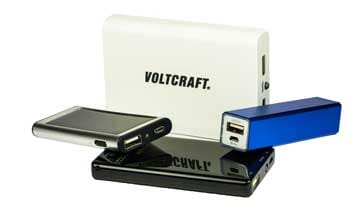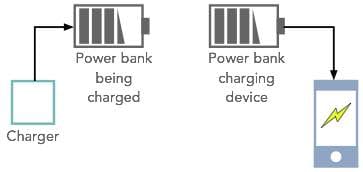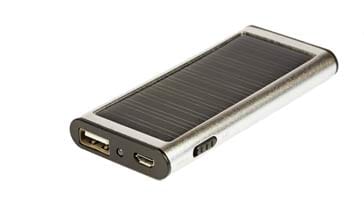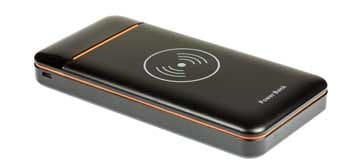What is a Power Bank - portable charger
Power banks are used for providing portable power to charge battery powered items like mobile phones and other similar items that have a USB interface: they can charge via USB, etc or wirelessly.
Power Banks Includes:
What is a Power Bank
How a power bank works
How to use a power bank
How to buy best power bank
Wireless charging power bank
Power banks are commonplace and with our increasing use of battery powered equipment: everything from mobile phones to battery powered headphones, portable speakers, MP3 players can be charged via a power bank. They are effectively a portable charger. All they need is a USB charging interface.
Power banks come in a variety of shapes and sizes and to suit many different people and their needs.

In recent years, the use of power banks has risen significantly as they provide a very convenient and easy method of charging smartphones and other devices when away from mains power. Wireless charging power banks have also been introduced for those devices that can be charged wirelessly.
Power bank definition
Power banks, sometimes speed as powerbanks, can be defined as portable batteries that use circuitry to control any power in and power out. They can charged up using a USB charger when power is available, and then used to charge battery powered items like mobile phones and a host of other devices that would normally use a USB charger.
The name power bank can be likened to a financial bank where funds can be deposited, stored, and withdrawn when needed. These items are also often referred to as portable chargers, as they can charge items like mobile phones without the need to be connected to the mains during charging, although they will need to be charged, and this normally requires a mains charger.

Power bank types
There are a few different types of power bank portable charger that can be bought. Obviously the size is one of the main criteria, but there are some other categories that can be considered.
The main types of USB power banks include the following:
Universal or standard power bank: These are the normal power bank portable chargers which are available in the stores and online. They are charged from the normal USB sources like USB chargers.
These power banks are normally charged from a standard USB charger and there is some indication on the power bank as to its state of charge. This may be a row of small LED lamps or a simple alphanumeric display that indicates the charge level as a percentage of full charge. Typically a micro USB connector is used as the power in connection.
Once fully charged the power bank can be used to charge other devices. There may be one of more Type A USB sockets (dependent upon the particular power bank) that can deliver charge to the devices needing charging.
Solar power bank: As the name indicates, these solar power banks can use sunlight to charge up. To do this they have photovoltaic panels. These are really only able to trickle-charge the internal battery when placed in sunlight because the solar cells are relatively small, but nevertheless this can be a very useful function, but really only in very sunny or bright conditions.

A solar powered power bank
It can also be charged in the normal way, using the solar power for a slow trickle chargeAs the solar charging is slow, they can also be charged from a USB charger as well. The solar charging is a useful back-up, especially if you are travelling away from mains power. To ensure that the maximum amount of solar energy can be converted, some of the more advanced solar power banks have solar panels that fold out to present a larger area to the Sun. Even so, it can take over 24 hours to charge some, and as there obviously isn't bright sun at night, or even all day, it can take a considerable while to charge. As charge times, capacities, etc vary considerably, it is always best to take a close look at the figures, if there is a possibility of buying one.
Like the standard wired power bank, these solar powered ones have standard Type A USB connectors for the output or outputs and a micro USB for the input from a USB charger.
Wireless power bank: With many gadgets like phones, ear-pods and the like now having the capability to be charged wirelessly, this concept has been adopted by the power bank industry.
It is possible to obtain powerbanks that are themselves charged from a standard USB source, but they are able to charge phones and other wireless charging compatible electronic devices wirelessly.

Wireless power bank These powerbanks use the Qi standard that has been adopted by virtually all electronic devices that can be charged wirelessly. The electronic device to be changed is placed on the power bank - orientation is often important, so check with the instructions, a button typically has to be pressed to turn on the wireless charging capability, and then it all proceeds until the device is charged.
It is best to turn off the wireless charging power bank once the charging is complete and then the wireless charging circuitry is disabled and the powe rbank will not be discharged unnecessarily.
Power bank lifetime
There are two main forms of lifetime that are associated with power banks.
- Charge discharge cycles: Any rechargeable battery will gradually wear out. Normally the lifetime of a battery is quoted in terms of the number of charge discharge cycles it can undergo before its performance falls by a given degree. Some cheaper power banks may only have a life of 500 or so charge discharge cycles, but better ones will have lifetimes of many more charge discharge cycles.
- Self discharge time: All battery cells, whether rechargeable or primary have a certain level of self discharge. For rechargeable batteries these days with their own control circuitry, a small amount of power is required to keep these circuits alive. As a result there is only a finite time that a battery will remain charged.
A good power bank can hold charge for up to 6 months with only a small loss of charge, but lower quality ones may only retain a useful charge for about a month. These figures are for room temperature, but storing them outside these temperatures considerably reduces their performance.
Power bank charge & current capabilities
The level of charge that can be stored in power banks has risen as the need has grown. Smartphones are one of the chief items to be charged by them, and n recent years the battery capacities have increased significantly to provide longer times between charge.
Older power banks had capacities of possibly 1000mA hours, where as some of the latest ones available can offer huge capacities of 25000 mA hours.
Also the current that can be delivered by them is large as well. Often they can deliver 2.5A, enabling them to provide a fast charge for many electronic devices.
Power bank battery technology
All power banks use rechargeable batteries based around lithium technology. Lithium-Ion and Lithium-Polymer batteries are most commonly used for power banks but don’t be surprised if other types start to hit the market before long. Battery technology is key to many new developments: everything from mobile phones to electric vehicles, and as a result it is quite likely there will be some spin-offs into power banks.
The two technologies that are currently used have slightly different properties:
- Lithium-ion: Lithium-Ion batteries have a higher energy density, i.e. they can store more electrical charge in a given size or volume, and are cheaper to manufacture, but they can have issues with ageing.
- Lithium-polymer : Lithium-polymer power banks do not suffer from ageing to the same extent so are a better choice. However they are more costly to manufacture and as a result they may not suit all budgets. Sometimes it may be that it is best to spend less, especially if they are likely to be accidentally lost.
Both forms of power bank work well, but it is a balance between cost and performance.
Power bank portable chargers are particularly useful as they enable battery powered items to be charged on the go. As it is not always possible to reach a mains power point every time a mobile phone or other battery powered item needs charging, these power banks are have now become an established product and they are very useful, especially when travelling.
 Written by Ian Poole .
Written by Ian Poole .
Experienced electronics engineer and author.
More Equipment, Items & Gadgets:
Wireless charging
USB chargers
Power banks
E-readers
TV remotes
Webcam
Return to Electronic items menu . . .



